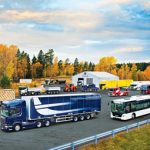SA rail transport: on the fast track?

Road or rail? The debate has been raging on for quite some time, with both sides offering numerous (valid) pros and cons. FOCUS takes a look at the South African rail industry to see if road transport actually has anything to fear from its railed rival
It’s no secret that road transport is king when it comes to moving freight in our country. “Rail volumes in South Africa have remained flat for the past 20 years, while road volumes have increased steadily,” explains Dewald Potgieter, technical executive at GIBB – a multi-disciplinary engineering consulting firm.
However, he adds that this isn’t a sustainable trend. “If a shift from road to rail doesn’t start to take place, the cost of transportation will continue to rise at greater levels than inflation.”
But goods need to get to their destination on time; something that isn’t always guaranteed with South Africa’s rail system. “Predictability needs to become a priority,” says Potgieter. “If a freight customer puts a consignment on the train, he wants to know it will arrive on time.” He adds that proper feasibility investigations also need to be conducted for all new projects.
Rail does, however, have its benefits. Besides the obvious reduction of congestion on our roads, a shift from road to rail makes sense from an environmental point of view. “Numerous studies show carbon emissions from railway transportation are, per tonne per kilometre, about half of those of goods transported by road,” Potgieter points out.
Transportation via rail also has an impressive safety record. “There is no comparison between road and rail with regard to accidents and fatalities,” states Potgieter. “Most fatalities linked to rail are as a result of illegal pedestrian crossings rather than train accidents.”
And, believe it or not, South Africa has one of the longest railway networks worldwide (about the 11th longest among the top 25 countries) with the leaders being the United States, Russia, China and India. “We are, however, only using about half of our 21 000 km of railway track,” says Potgieter.
Rail freight volumes have been static for the past 20 years, which is seeing South Africa loosing its global position as the 10th largest carrier of rail freight. “South Africa has been transporting just under 200 million tonnes of freight by rail per annum for the past two decades,” Potgieter points out. “Other countries have increased their freight volumes via rail. Russia, for example, transports about 65 percent of all its freight on rail while South Africa transports about
15 percent.”
He adds: “Looking at roads by way of comparison – 20 years ago, roughly 600 million tonnes of freight was being transported by road in South Africa. This has increased significantly and today close to 1 400 million tonnes of freight is transported via road annually.”
Admittedly, it is difficult for rail to compete with trucks. “Truck operators and owners do not pay directly for the maintenance of roads,” explains Potgieter. “Their contribution is through tax, fuel levy and tolls. Rail operators, on the other hand, own the railway infrastructure and, therefore, have to maintain it. This makes it more difficult for them to offer competitive tariffs for transportation because they have to maintain their assets as well.”
But this isn’t stopping rail operators. “Capital projects include modernising priority passenger corridors – in Gauteng, Cape Town and KwaZulu-Natal (KZN) – which will involve upgrading 20 of the busiest stations and the signalling system at a total spend of about R14,5 billion. GIBB is currently involved in the Gauteng and KZN projects,” Potgieter points out.
“On the freight side, Transnet is conducting similar projects, with the focus on creating additional capacity and achieving greater operational efficiency, to the tune of R200 billion over the next seven years,” he adds.
“The issue for Transnet is freight demand. Capital expenditure planning has identified projects that will respond to market demand, with the emphasis on partnering with clients to ensure the various long-term capital expansion projects are sustainable,” says Potgieter. “An example is the Transnet and Eskom collaboration for transporting coal to the Majuba Power Station.”
Five contracts to upgrade the yard controls at ten sites around South Africa, with a total value of R200 million, have been awarded to Actom Signalling (a railway signalling specialist company) by Transnet Capital Projects – on behalf of Transnet Freight Rail (TFR).
Peter Colborne, Actom Signalling’s general manager, explains: “The new yard control system is semi-automated and replaces the existing manually operated mechanical system, in which points sets are thrown by a yard operator on the tracks.”
The ten yards covered by the five contracts are: Elandsfontein and Capital Park in Gauteng; Richards Bay, Nsezi and Fynnlands in Kwazulu-Natal; Bellville in the Western Cape; Postmasburg in the Northern Cape; and Coega, Green Street and Foreshore in the Eastern Cape.
“In our bid for these contracts we offered two solutions – one consisted of a mix of existing equipment and purpose-designed equipment that we would have to develop, while the second alternative solution involved developing all the key equipment from scratch,” Colborne explains.
“TFR selected the second (lower-cost) option; a decision which we view as a major vote of confidence in Actom’s product development team.”
He adds: “One complication was that the execution of the contracts overlapped with the development of the new equipment, resulting in us having to start manufacturing some of the products before the development work had been completed. Consequently we had to modify early points machines and points indicators that we had developed.”
Colborne continues: “However, TFR later extended the completion dates of all the contracts by three months to allow us more time to develop and test the new equipment. The individual contracts are now scheduled for commissioning by December this year.”
He says that the contracts require the design and development of a new points machine, points indicator and axle-counter, with features specifically applicable to yard control. “This was the most challenging part of the whole project, because all of these new items of equipment had to be developed, tested and proven, within a very short time-span,” Colborne emphasises.
Actom Signalling arranged with sister company Actom Mechanical Equipment – which is situated next door to its premises in Driehoek, Germiston – to provide assistance by undertaking the supervision of the assembly of the points machines, points indicators and equipment enclosures at its factory.
“This has been a great help towards enabling us to keep pace with the contract requirements and tight deadlines of the project,” Colborne points out.
So it would seem that road’s railed rival might be a formidable contender as industry players band together and new partnerships are formed … However, perhaps the question shouldn’t be road or rail? But rather: What’s better for our country?
“We support infrastructure spend being weighted towards rail and are positioned to assist government and parastatals in a professional partnership capacity,” says Potgieter. “As a company of professional engineers, who subscribe to a professional code of conduct, we are obliged to act on behalf of the public. We know it is in the long-term interest of society to find the right balance between road and rail usage.”
Published by
Focus on Transport
focusmagsa




